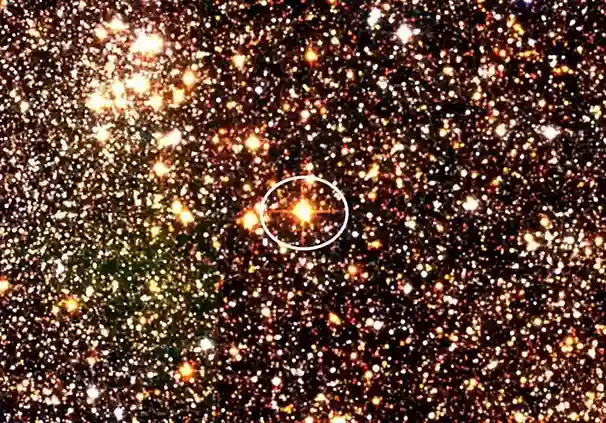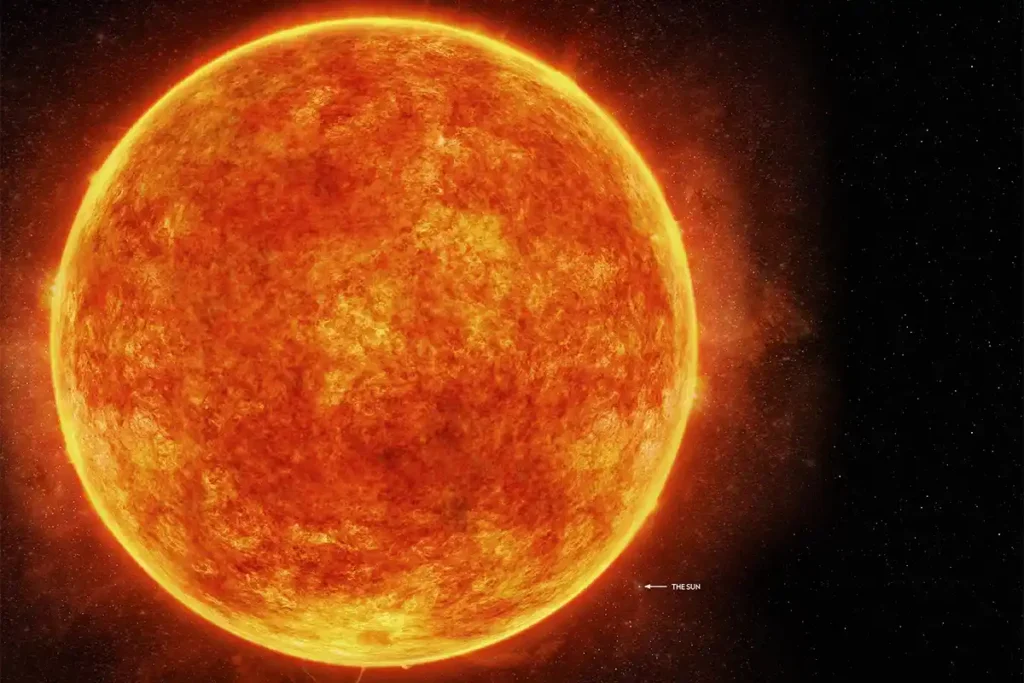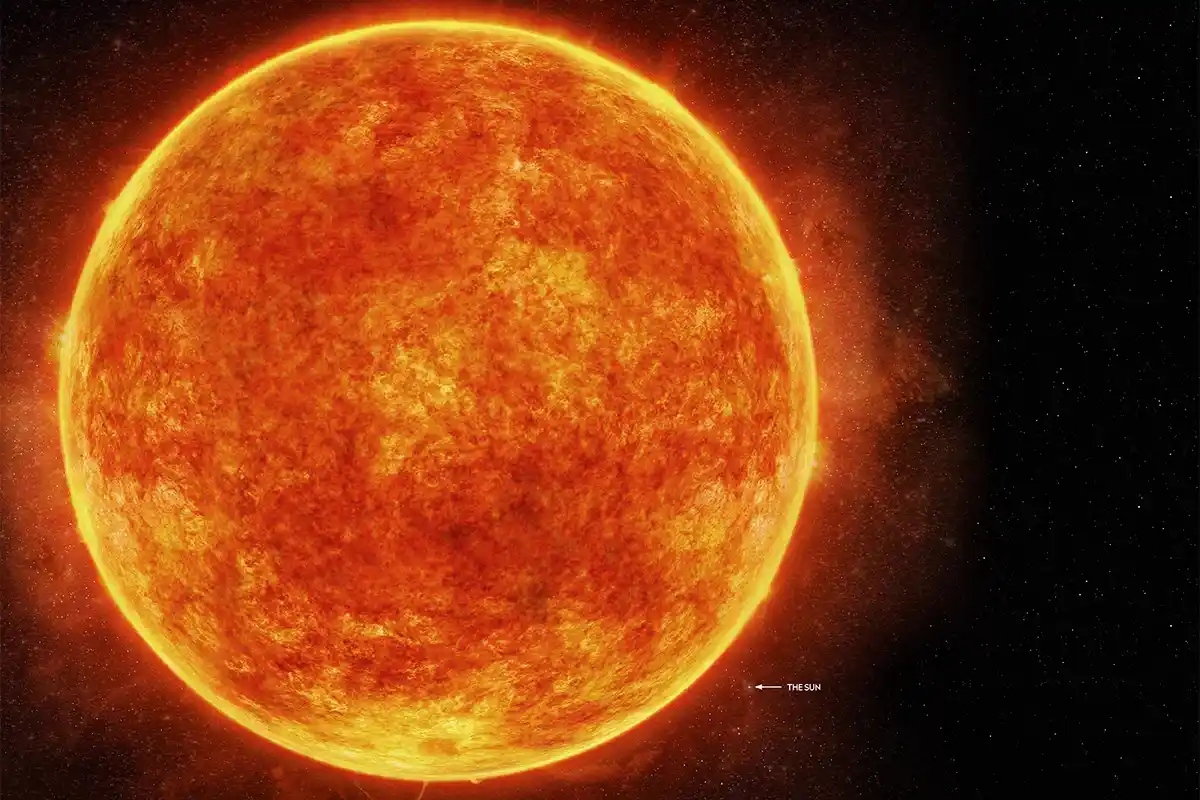Stephenson 2-18 is a hypergiant star (most luminous and massive stars known in the universe), located in the Stephenson 2 cluster, has earned its place as the biggest star in the universe. But how big is Stephenson 2-18? Let’s explore the fascinating details of this astronomical marvel.
Table of Contents
About Stephenson 2-18?
Stephenson 2-18, also known as Stephenson 2 DFK 1, is a red hypergiant star situated in the Milky Way galaxy. It resides approximately 19,500 light-years away from Earth in the constellation Scutum. This colossal star is part of the Stephenson 2 cluster, a group of massive stars discovered in the late 20th century.
Stephenson 2-18 is believed to be nearing the final stages of its life cycle and is anticipated to eventually explode as a supernova, likely becoming one of the most powerful explosions ever observed in the Milky Way.

How Big is Stephenson 2-18?
To understand the sheer size of Stephenson 2-18, consider this: its radius is estimated to be around 2,150 times that of the Sun. If located at the centre of our solar system, the star’s outer boundary would reach far beyond Saturn’s orbit! Such an immense size makes it nearly impossible to fathom using everyday measurements.
To put it into perspective, Stephenson 2-18 is over 10 billion times the volume of the Sun. This staggering size makes it the largest star ever discovered, dwarfing other well-known giants like Betelgeuse and UY Scuti. UY Scuti was once considered the largest known star, which has a radius about 1,700 times that of the Sun, making Stephenson 2-18 significantly larger.
The immense size of Stephenson 2-18 can be attributed to its evolutionary stage and mass. As a red hypergiant, it has expanded significantly due to the fusion processes occurring in its core. Its mass, estimated to be around 40 times that of the Sun, contributes to its ability to reach such a vast size.
Detailed information breakdown
1. Discovery
First identified as part of the Stephenson 2 cluster in 1990 by Charles Bruce Stephenson.
2. Identification & Location
- Type: Red hypergiant star
- Cluster: Part of the Stephenson 2 (RSGC2) cluster
- Location: Scutum Constellation (Milky Way Galaxy)
- Distance from Earth: Approximately 19,500 light-years (6,000 parsecs)
- Right Ascension: 18h 39m 02.3709s
- Declination: −06° 05′ 10.5357″
- Radial velocity (Rv): 89 km/s
3. Visibility
Not visible to the naked eye because of its vast distance and surrounding interstellar dust.
4. Size
- Radius: Estimated to be 2,150 times the Sun’s radius.
- Volume: Over 10 billion times the volume of the Sun.
- Mass: Estimated to be around 40 solar masses.
- Although its mass is far less than its volume suggests, this is typical for hypergiant stars, as their outer layers are extremely diffuse.

5. Luminosity
- Approximately 440,000 times the Sun’s luminosity.
- This immense brightness makes it one of the most luminous red hypergiants known.
6. Chemical Composition
- Primary Elements: Hydrogen, Helium (result of nuclear fusion processes), Carbon, Oxygen and traces of Nitrogen and other metals.
7. Origin and Evolution
- Formation: Likely formed from a massive molecular cloud in the Scutum constellation.
- Evolutionary Stage:
- Currently in the late stages of stellar evolution.
- Classified as a red hypergiant, a rare phase that occurs in the lifecycle of the most massive stars.
- Expected to end its life in a supernova explosion, potentially leaving behind a black hole.
8. Temperature
- Surface Temperature: Estimated to be around 2926.85 °C (5300.33 °F).
- Cooler than smaller stars like the Sun, which has a surface temperature of about 5504.85 °C (9940.73 °F).
- Its red colour is indicative of its relatively low surface temperature.
The Life Cycle of this Hypergiant
Stars like Stephenson 2-18, the biggest star in the universe, are rare, massive, and short-lived, burning through their nuclear fuel at an extraordinary rate. As a red supergiant, it has already exhausted its primary fuel sources, such as hydrogen and helium, and is likely fusing heavier elements in its core—a hallmark of massive stars nearing the end of their lives. Once its core can no longer sustain fusion due to the formation of iron, it will collapse under its own gravity, triggering a dramatic supernova explosion.
This immense explosion will release vast amounts of energy, ejecting the star’s outer layers into space and contributing to the formation of new stars and planets. Given Stephenson 2-18’s colossal size and luminosity, its supernova is expected to be one of the most powerful explosions ever observed in the Milky Way, potentially leaving behind a black hole.


